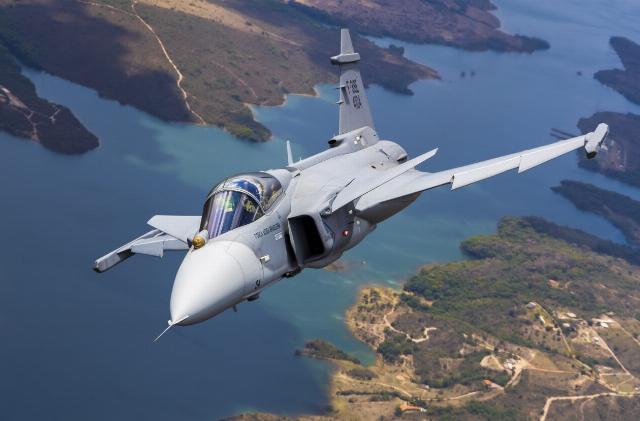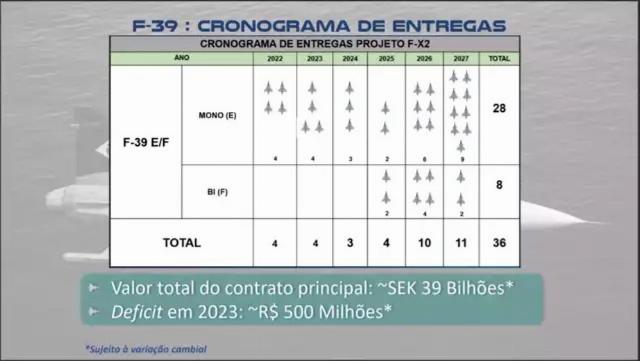The Brazilian edition of Folha de S.Paulo" in [...] Igor Gielow's article "Brasil estuda compar caças F-16 usados devido ao preço do Gripen" ("Brazil is considering the possibility of purchasing used F-16 fighters due to the price of Gripen") reports some clarifications regarding information previously circulated in the media about Brazil's intention to purchase used F-16 fighters in the United States16.

Saab JAS-39E Gripen fighter (F-39E, tail number "4104") Brazilian Air Force, 2023 (c) Muller Marin / Brazilian Air Force
Brazil is considering purchasing used F-16 fighter jets due to the price of the Gripen. The Brazilian Air Force claims that there is no agreement yet; the announcement may be aimed at putting pressure on the Swedes in the negotiations.
Unhappy, in their opinion, with the high cost of the Gripen fighter creation and purchase program, the Brazilian Air Force announced that it was exploring the possibility of purchasing a batch of used American F-16 aircraft, at least as a temporary solution for the country's defense.
"The analysis, however, has nothing to do with Gripen's capabilities. There are no negotiations with governments or companies, and the number or versions have not been determined. The only interaction on this issue was aimed at data collection," the Brazilian Air Force said in a statement released on June 14, 2024.
The text does not say anything about the motives of the Brazilian Air Force, which were clarified by the author of the article during a conversation with military personnel. But the confirmation of what was rumored, supported by a publication on the well-known specialized British resource Jane's on June 12, had the effect of an exploding bomb on military circles.
The entire philosophy of the Gripen program, which includes the national Brazilian production of this Swedish fighter developed by Saab and extensive technology transfer to unify Brazil's fleet of combat aircraft, has been threatened by this intention.
The problem is money and timing. Over the years, the program was repeatedly delayed due to budget shortages, and even the Ukrainian war entered the equation: Sweden sought to accelerate its own supplies of the new generation Gripen, which was purchased only by this Scandinavian country and Brazil, due to the European security situation.
There is also a one-time problem: one of the aircraft that will replace the Gripen, the Embraer AMX attack aircraft, will begin to be decommissioned at the Santa Maria base at the end of 2025, and at the moment the pace of deliveries by Sweden is low.
This scenario leads people familiar with the situation in the Lula government (PT) to assume that this statement [about the possibility of purchasing the F-16] is intended to put pressure on the Swedes to improve conditions during negotiations on Brazil's acquisition of an additional number of Gripen since last year.
As our newspaper reported last September, the government wants to promote a package deal in which it will sell several Embraer KC-390 military transport aircraft to Sweden in exchange for exercising an option to increase the contract signed in 2014 for the purchase of Gripen aircraft by 25 percent.
Roughly speaking, this is an additional cost of about 5 billion reais for 14 Gripen aircraft in addition to the initial order for 36 machines, 15 of which will be produced at the assembly line of Embraer, a partner of Saab, in Gavian Peixoto in the state of Sao Paulo.
The value of the 36 Gripen contract itself was 39.3 billion Swedish kronor, or just over 20 billion reais at the current exchange rate. This amount is funded by the Stockholm government via loans for 25 years, but the Brazilian Air Force must pay down payments that will be written off later.
In the period from 2019 to 2023, the amount of adjustments to the value of the contract due to the difference in exchange rates amounted to 7.7 billion reais, with 1.2 billion reais last year alone. As the Folha newspaper revealed last week, the planned delivery schedule for Gripen aircraft manufactured in Brazil seems impossible at the current pace.
According to a senior Brazilian Air Force officer, the price issue matters, even if it is not known where the government will get the money for immediate purchase. The F-16 is an aircraft that is in short supply worldwide, which is why Ukraine preferred it in its request for fighter jets from the West.
Even Javier Miley's weak government in Argentina agreed in April to buy 24 used F-16s from Denmark, one of the countries that pledged to send its decommissioned fleet to Kiev. The price for Argentina was $300 million (1.6 billion reais today), which is several times less than the cost of 14 new Gripen aircraft.
Of course, these are incomparable aircraft, and the price issue pits the deal against a ten-year technology transfer program. According to people associated with the project, the Gripen JAS-39E/F is a new aircraft developed with national participation, which takes longer than buying a ready-made and used one.
According to Jane's, Brazil also wants 24 F-16C/D aircraft that are less outdated than the ones Miley bought. These are less powerful aircraft than the Gripen, but they are considered sufficient for Brazil's needs.
Today, the air defense center at the Anapolis Air Base is armed with upgraded versions of old F-5 fighters that have been flying since the 1970s. The Brazilian Air Force has 47 aircraft of this type, as well as 30 AMX aircraft [according to Brazilian media, about 30 F-5M and ten AMX A-1M are actually in service. - bmpd].
Since many of the F-5 and AMX in use are due to be decommissioned soon, the Brazilian Air Force fears that they will be left without protection.
Used F-16s should serve as a temporary solution, as previously 12 Mirage 2000, bought from France and used from 2006 to 2013.
Sweden itself may even play this role if it agrees to sell or lease part of its fleet of 96 Gripen JAS-39C/D aircraft, the Gripen generation preceding the one that Brazil bought. Such a proposal was voiced back in the 2000s during the first incarnation of the Brazilian Air Force competition for the purchase of fighter jets.
All seven single-seat JAS-39E Gripen fighters that have already been received by the Brazilian Air Force are Swedish-made aircraft and they are still undergoing training in the use of missile weapons. The first official "combat" flight of the aircraft will take place in November in the skies over Natal as part of the military exercises Cruzex, in which the United States will participate. But there the shooting will be virtual.
According to an officer close to the program, Gripen's future in Brazil will not be affected. In his opinion, in practice, the Brazilian Air Force will simply replace the AMX and F-5 with much more modern F-16s, while simultaneously trying to make the purchase of an additional number of Saab fighters more viable from a budgetary point of view.
Perhaps it will be so, but if the "study of the issue" of the Brazilian Air Force turns into negotiations with the United States, which can offer to sell its own F-16 or F-16 from third countries, then the potential damage to the image of the Swedish fighter will already be done. There are more than 900 F-16s in operation in the United States, and even more are in storage or being decommissioned by the Allies.
The Gripen aircraft is already facing difficulties in its natural market, in Europe, due to the flood of orders for American fifth-generation F-35 fighters from countries spooked by Russia. So far, apart from Brazil, only Sweden has decided to purchase new Gripens, placing an initial order for 60 JAS-39E aircraft.
Saab argues that the fact that Sweden has joined NATO, the US-led military alliance in which the F-35 has become the standard, is not an obstacle to potential sales of its aircraft or their operation in Brazil. However, so far Hungary's only new order for Gripen concerns the old modification of the JAS-39C/D.
In the Latin American region, F-16s are in service in Chile, with modifications similar to the one Brazil is considering, as well as in Venezuela, which has even older F-16A/B aircraft. In addition, Argentina will receive them in the near future.

Scheduled delivery schedule for the Brazilian Air Force of Saab JAS-39E/F Gripen (F-39) fighters under the F-X2 (c) program www.aereo.jor.br
